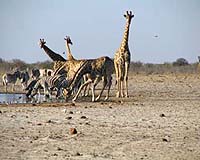| . |  |
. |
Hamburg, Germany (SPX) Feb 12, 2010 In order to regulate their body temperature as efficiently as possible, wild female bats switch between two strategies depending on both the ambient temperature and their reproductive status. During pregnancy and lactation, they profit energetically from clustering when temperatures drop. Once they have finished lactating, they use torpor to a greater extent, to slow their metabolic rate and drop their body temperature right down so that they expend as little energy as possible. These findings by Iris Pretzlaff, from the University of Hamburg in Germany, and colleagues, were just published online in Springer's journal Naturwissenschaften - The Science of Nature. When energy demands are high, such as during pregnancy and lactation, female bats need to efficiently regulate their body temperature to minimize energy expenditure. In bats, energy expenditure is influenced by environmental conditions, such as ambient temperature, as well as by social thermoregulation - clustering to minimize heat and energy loss. Torpor, another common temperature regulation strategy, has disadvantages for reproductive females, such as delayed offspring development and compromised milk production. Pretzlaff and team investigated, for the first time in the wild, the thermoregulation strategies used by communally roosting Bechstein's bats during different periods of their reproductive cycle - pre-lactation, lactation, and post-lactation. They collected data from two maternity colonies roosting in deciduous forests near Wurzburg in Germany, predominantly in bat boxes. The authors measured ambient temperature over those three periods as well as the bats' metabolic rate by using respirometry (measuring the rate of oxygen consumption).They found that the bats' metabolic rate was strongly influenced by the ambient temperature. However, by roosting in groups (social thermoregulation), the bats were able to regulate their body temperature more effectively, despite changes in daily ambient temperature. The bats also used torpor to minimize energy expenditure, particularly post-lactation - more than twice as often than during the other two periods. This suggests that they predominantly use torpor once they can afford to do so without compromising offspring development and milk production. They also formed much smaller groups post-lactation when temperatures were lower because roosting in smaller groups reduces the risk of disturbances by conspecifics. This resulted in longer torpor bouts and therefore longer periods of energy saving. The authors conclude: "We were able to demonstrate on wild Bechstein's bats, during different reproductive periods, the significance of behavioral and physiological flexibility for optimal thermoregulatory behavior. Our study also highlights the importance of field studies, where the animals can use their behavioural and physiological repertoire, which is often not possible under the generally more controlled regimes in laboratory studies."
Share This Article With Planet Earth
Related Links University of Hamburg Darwin Today At TerraDaily.com
 Kenya rounds up prey for starving lions
Kenya rounds up prey for starving lionsSoysambu Conservancy, Kenya (AFP) Feb 10, 2010 Kenyan game rangers on Wednesday began rounding up thousands of zebras to be moved to a reserve where starving lions have been attacking livestock. The spectacular nationwide operation, launched in Soysambu conservancy by the Kenyan Wildlife Service (KWS), is due to last until the end of the month in what will go down as one of Africa's largest animal translocations yet. Shortly after da ... read more |
|
| The content herein, unless otherwise known to be public domain, are Copyright 1995-2010 - SpaceDaily. AFP and UPI Wire Stories are copyright Agence France-Presse and United Press International. ESA Portal Reports are copyright European Space Agency. All NASA sourced material is public domain. Additional copyrights may apply in whole or part to other bona fide parties. Advertising does not imply endorsement,agreement or approval of any opinions, statements or information provided by SpaceDaily on any Web page published or hosted by SpaceDaily. Privacy Statement |